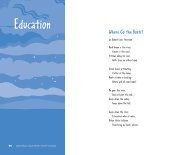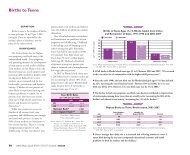2010 Rhode Island Kids Count Factbook
2010 Rhode Island Kids Count Factbook
2010 Rhode Island Kids Count Factbook
Create successful ePaper yourself
Turn your PDF publications into a flip-book with our unique Google optimized e-Paper software.
Schools Making Insufficient Progress<br />
DEFINITION<br />
Schools making insufficient progress is<br />
the percentage of <strong>Rhode</strong> <strong>Island</strong> public<br />
schools making insufficient progress as<br />
classified by the <strong>Rhode</strong> <strong>Island</strong><br />
Department of Elementary and<br />
Secondary Education. Classification<br />
levels include: “Insufficient Progress,”<br />
“Caution,” “Met Adequate Yearly<br />
Progress (AYP),” and “Met AYP and<br />
Commended.” Classifications are based<br />
on 37 measures of school performance.<br />
<strong>Rhode</strong> <strong>Island</strong>’s accountability system is<br />
designed to promote an increase in<br />
educational outcomes so all students<br />
reach proficiency by 2014, as required<br />
by the federal No Child Left behind Act<br />
of 2001.<br />
SIGNIFICANCE<br />
The 2001 federal No Child Left<br />
Behind Act (NCLB) is aimed at closing<br />
achievement gaps and improving public<br />
schools. Through improved standards<br />
and accountability and increased testing<br />
and reporting requirements, NCLB is<br />
intended to focus on improving<br />
educational outcomes for all students<br />
with special attention paid to key<br />
demographic groups. The law is also<br />
intended to improve educator quality<br />
and expand options for students. 1<br />
The concept of standards-based<br />
education relies on four cornerstones:<br />
making learning goals explicit, ensuring<br />
teachers are using curricula aligned with<br />
the standards, providing the necessary<br />
resources, and developing tests and<br />
implementing accountability systems<br />
closely aligned with the learning goals. 2<br />
Accountability systems are insufficient<br />
without deliberate interventions to<br />
improve educator quality and to provide<br />
extra resources to students at risk of<br />
failure. 3<br />
Testing student performance in<br />
reading and mathematical skills can<br />
indicate how well schools are preparing<br />
students to succeed in higher education<br />
and the labor market. Students with<br />
higher test scores are more likely to<br />
graduate from high school, attend<br />
college, earn more and have more stable<br />
employment than students with lower<br />
test scores. 4<br />
High poverty schools can improve<br />
student performance by regularly<br />
communicating high expectations for<br />
students and staff, nurturing positive<br />
relationships among adults and<br />
students, having a strong focus on<br />
academic instruction, providing<br />
ongoing professional development for<br />
staff connected to student achievement<br />
data, using student assessments to<br />
individualize instruction, making<br />
decisions collaboratively, employing<br />
enthusiastic and diligent teachers, and<br />
effectively recruiting, hiring and<br />
assigning teachers to maximize success. 5<br />
% of Schools<br />
100<br />
90<br />
80<br />
70<br />
60<br />
50<br />
40<br />
30<br />
20<br />
10<br />
0<br />
100%<br />
90%<br />
80%<br />
70%<br />
60%<br />
50%<br />
40%<br />
30%<br />
20%<br />
10%<br />
0%<br />
2009 <strong>Rhode</strong> <strong>Island</strong> School Performance Classifications<br />
Core Cities Remainder of State <strong>Rhode</strong> <strong>Island</strong><br />
36%<br />
5%<br />
15%<br />
% Insufficient Progress % Caution % Met AYP % Met AYP & Commended<br />
Source: <strong>Rhode</strong> <strong>Island</strong> Department of Education, 2008-2009 school year.<br />
◆ In <strong>Rhode</strong> <strong>Island</strong> in 2009, 225 schools (76%) were classified as “Met Adequate<br />
Yearly Progress (AYP),” 16 additional schools (5%) were classified as “Met AYP and<br />
Commended,” 12 schools (4%) were classified as “Caution,” and 44 schools (15%) were<br />
classified as making “Insufficient Progress.” 6<br />
◆ School classifications are based on 37 targets that include school-wide English and<br />
mathematics targets, English and mathematics targets for student groups, school-wide<br />
and student group test participation targets, and attendance or graduation rate targets<br />
(depending on whether the school is an elementary/middle school or a high school).<br />
English and mathematics targets are evaluated using New England Common Assessment<br />
Program (NECAP) test and other state test results. 7<br />
◆ Schools that do not miss any current targets are classified as “Met AYP.” Schools that<br />
achieve exceptionally high performance in English or Mathematics for two years, make<br />
significant progress for two years or significantly closed achievement gaps between student<br />
groups are designated as Regents Commended Schools (“Met AYP and Commended”).<br />
Schools that miss up to three targets for the first time (other than school-wide English and<br />
mathematics targets) may be classified as “Caution” for one year only. Schools that miss a<br />
school-wide English or math target, more than three targets, or schools that miss any target<br />
for multiple years are classified as making “Insufficient Progress.” 8<br />
◆ Schools that are classified as making “Insufficient Progress” may face state interventions,<br />
including the implementation of a corrective action plan or restructuring by the state. 9<br />
59%<br />
84%<br />
76%<br />
8%<br />
5% 3% 4% 5%<br />
0%<br />
142 <strong>2010</strong> <strong>Rhode</strong> <strong>Island</strong> KIDS COUNT <strong>Factbook</strong> / Education






